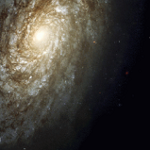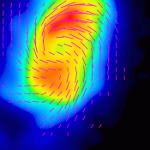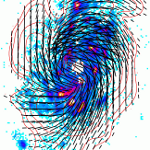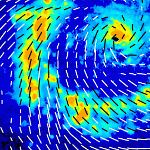Flocculent galaxies possessing no strong density wave action
One of topics of our research concentrates on following question: Is the magnetic spiral structure of galaxies an ultimate result of density wave flows? Here we present our observations of magnetic field structure in flocculent galaxies possessing no evident density wave action. These are: NGC 4414 observed with the VLA (top panel) as well as NGC 3521 and NGC 5055 (bottom panels). The optical image of NGC 4414 is from HST archives. Other optical images are from the Digital Sky Survey.
This is NGC 4414 - a flagship example of a flocculent galaxy. Here there is an overlay of the total power emission at 3.6 cm as seen by VLA D-array with B-vectors of polarized intensity. Note the total power hole in the centre, indicating that there has been no gas inflow into the galaxy's centre over some 108 - 109 yrs ago. This excludes the radial inflows as a cause of a radial magnetic field component (seen here clearly as spiral-like, rather than a ring-like magnetic structure).
The magnetic field spiral structure seen here to a larger extent when a natural weighting (sensitive to smooth extended structures). The magnetic structure has been overlaid upon that in Ha emission (in colours). Usually, the Ha emission traces well the "grand-designs" spiral structure (apparently missing here). Nevertheless ordered spiral (strong radial component!) is shown by the magnetic field. This is a good case for the dynamo actioni. Details can be found at Soida et al. 2002.
The question arises: in NGC 4414 really unique? Are the radially inclined fields a common property of flocculent, non density wave galaxies?
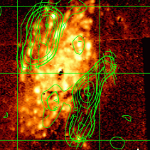 Example 1 - NGC 3521 This is a picture of polarized intensity of this galaxy
taken with the Effelsberg radio telescope at 2.8 cm (resolution of 1.2").The
heat-scale image is that in Ha line taken for this project by R-J. Dettmar.
Example 1 - NGC 3521 This is a picture of polarized intensity of this galaxy
taken with the Effelsberg radio telescope at 2.8 cm (resolution of 1.2").The
heat-scale image is that in Ha line taken for this project by R-J. Dettmar.
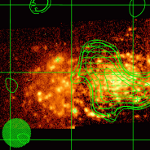 Example 2 - NGC 5055 This is a picture of polarized intensity of this galaxy
taken with the Effelsberg radio telescope at 2.8 cm (resolution of 1.2").The
heat-scale image is that in Ha line taken for this project by R-J. Dettmar. In
both cases little organized spiral structure is seen in the Ha line (in contrast
to grand-design spirals). Again a good case for the dynamo action.
Example 2 - NGC 5055 This is a picture of polarized intensity of this galaxy
taken with the Effelsberg radio telescope at 2.8 cm (resolution of 1.2").The
heat-scale image is that in Ha line taken for this project by R-J. Dettmar. In
both cases little organized spiral structure is seen in the Ha line (in contrast
to grand-design spirals). Again a good case for the dynamo action.
The words of truth for the flocculent galaxies observed with the Effelsberg radio telescope: note that the maxima of polarized emission (upper picture) are shifted from their expected position of 90/270° as expected from purely azimuthal fields. Instead, the polarization maxima are shifted either leftwards (NGC 3521) or rightwards (NGC 5055) relative to this expected position.
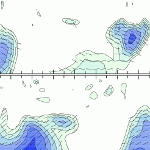 As shown by the numerical models of magnetic field structures (a bottom panel)
this is a clear indication of the existence of a substantial radial
magnetic field, despite the evidence of no radial streaming of the gas (no
density waves identified). The pictures show the case of an axisymmetric field,
the spiral one wound counterclockwise (NGC 3521) and that wound clockwise (NGC
5055). All this works in a support of the dynamo action, generating strong
radial magnetic fields without global radial flows. Details are in the work of
Knapik et al. 2000.
As shown by the numerical models of magnetic field structures (a bottom panel)
this is a clear indication of the existence of a substantial radial
magnetic field, despite the evidence of no radial streaming of the gas (no
density waves identified). The pictures show the case of an axisymmetric field,
the spiral one wound counterclockwise (NGC 3521) and that wound clockwise (NGC
5055). All this works in a support of the dynamo action, generating strong
radial magnetic fields without global radial flows. Details are in the work of
Knapik et al. 2000.
The most spectacular example of a spiral magnetic field with a strong radial component against a generally ring-like, azimuthal geometry (and also kinematics!) of the galaxy. The underlying Ha image shows the star-forming azimuthal ring at the Inner Lindblad Resonance (ILR), the place where a strong azimuthal shear is expected. Superimposed are the B-vectors at 3.6 cm observed with the VLA D-array. Against that shear, the magnetic field has a strong radial component (possibly supported by a strong dynamo action). See Chyży & Buta 2008.

